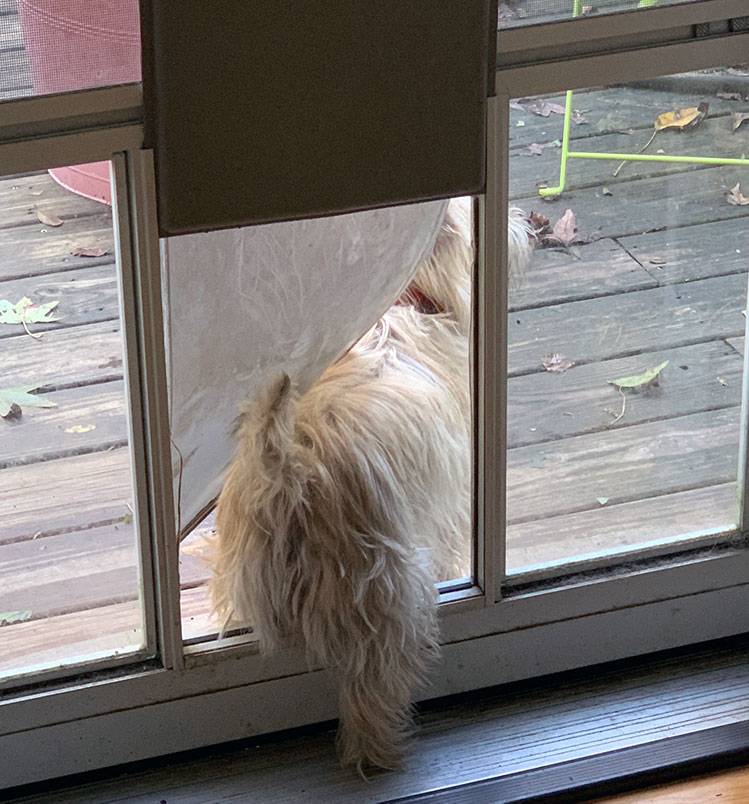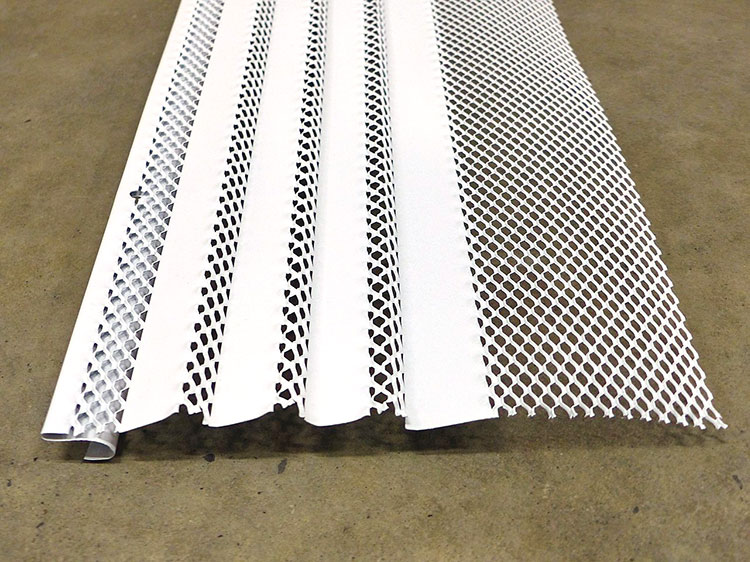While dogs are great companions, sometimes they do things that can be annoying from a human perspective.
One of those things is scratching the door. I know from experience how frustrating it is to find claw marks on a recently painted door. I’ve been there (too) many times.
In this article, I’ve collected the best and most effective methods I’ve found over the years to help you find a viable solution without wasting your time.
To successfully prevent your dog from scratching the door (or the jamb), first, you need to understand the possible reasons behind your dog’s behavior.
7 Common Reasons Why a Dog Scratches a Door
If your dog is scratching the door from the outside, the most likely causes are the following:
- Separation anxiety. When dogs are closely attached to their owner, leaving them alone even for a short period of time might cause extreme distress. Often they try to bypass the barrier (in this case the door) that separates them from their guardian or call the owner’s attention by scratching the door. Contrary to popular belief, separation anxiety can appear not only in puppies but in adult dogs as well.
- Hunger. Sometimes the only reason why a dog scratches the entrance door is that they’re hungry and that’s a unique way for them to call your attention. This scenario mostly occurs when your dog realizes that the food always comes from the house and they associate the opening door with food.
- They want to go inside. There could be many reasons why a dog wants to get inside, including harsh weather conditions, loneliness, tiredness, or fireworks. More often than not, they just want your company (it’s especially true if you have a puppy).
- They want to call your attention. Here’s an example: my dog used to scratch and jump on the door each time when she found something she thought would be interesting for me (including bugs, roots, etc.).
If your dog is scratching the door from the inside, one of these might be the reason:
- They need some physical activity. In order to maintain their health, dogs, just like humans, need to do some moderate to high-intensity exercises, such as running or walking, every day. Inside a house (or an apartment) there’s only limited space available that might not be enough to satisfy your dog’s need for exercise.
- They’re bored. When dogs feel bored, they tend to do all kinds of things that seem to be entertaining for them, including scratching the door or the jamb.
- They want to go outside. There are many reasons why a dog wants to leave the house. They may have to go potty, see (or hear) something outside that catches their interest or they may just want to go for a walk. In these cases, a trained dog usually won’t start scratching and damaging the door right away, instead, they try to call their owner’s attention by barking or changing their behavior.
- They’re missing their guardian or they’re anxious. When you leave home, your dog doesn’t know that you go to work (or elsewhere), all they see is that you disappear behind the door. Dogs love company (some breeds more than others) and if you spend most of your day away from home, they might become lonely or anxious. Puppies are particularly sensitive to being alone.
Now let’s see the solutions, one by one:
1. Door Scratch Shield
There are several door scratch protectors available on the market. Most of them work in a very similar way. They are made of some kind of plastic that you need to attach to the door using the included tools.
Some door scratch shields require no tools for installation (all you need to do is hang them over the doorknob) while others should be mounted on the door using the supplied adhesive tape, velcro pads, etc.
Those models that you need to pop over the knob usually protect only part of the door (not full width) but they’re designed to cover the jamb too.
If you need a ready-to-use solution and don’t want to spend time creating a homemade door protector, choosing a heavy-duty door shield would be a practical choice.
I recommend you opt for a model that’s easily removable and requires no installation, such as this one. Let’s see some of its benefits and drawbacks.
Advantages:
- it’s a hassle-free solution, no hardware is required to install
- it protects the jamb
- easily removable without damaging the paint or the finish
- can be trimmed with household scissors
Disadvantages:
- it might not be the best solution for larger dogs (they may pull it off the knob)
- it doesn’t cover the full width of the door
- could be more durable and thicker
2. DIY Door Scratch Protector
This method is on the top of the list for a reason: it’s a highly effective, simple, and affordable way to protect any door from pet scratches. While this is a DIY solution, it does not require any special skills.
All you need is
- a thin sheet of Plexiglas (1/8 or 1/16-inch thick, for larger dogs, choose the thicker one),
- a utility knife or glass cutter,
- some roundhead screws (plus a drill), heavy-duty double-sided mounting tape (be careful, it might remove paint from the door), or velcro hooks, depending on how you want to fix the plexiglass on the door.
If you have a metal door, you can also use magnets to fix the door shield.
As you can see, you can choose from several methods to mount the acrylic sheet. In most cases, I prefer using double-sided adhesive tape.
FYI: Don’t worry if you don’t have a glass cutter or a utility knife: you can ask the staff at your local hardware store to cut the plexiglass according to your needs.
Pro Tip: If you want to use screws, keep in mind that plexiglass can crack easily during drilling, so always drill slowly and carefully. Start with drilling a tiny diameter pilot hole and then gradually increase the size of the hole. Always wear safety gloves and goggles.
Instead of plexiglass, you can also use any other kind of plastic sheet such as a vinyl plastic floor protector (the one you use on carpets) or Lexan which is more durable but also more prone to scratches.
Here’s the full process step-by-step in a short video:
I suggest you cover the full width of the door. The height of the protector depends on how high your dog can jump. If the door protector reaches the doorknob (because you have a larger dog), you need to cut a circular hole in the Plexiglas.
You can use this shield on wood doors, metal doors, screen doors, and most types of sliding glass doors. It can be installed on almost any kind of door.
Also, it can be used on both exterior and interior doors, such as bedroom doors. In most cases, it prevents damage even from aggressive scratching. It’s a really powerful and easily customizable way of protecting doors from dog scratches.
To be honest, it’s my favorite way to prevent a dog from scratching a door. While it’s a great solution to protect the door itself, unfortunately, you can’t use it for the jambs. If you want the door frame to remain scratch-free, check out the next method on the list.
3. Use a Pet Scratch Protection Film to Protect the Jambs
While a Plexiglas shield will prevent your dog from leaving claw marks on the door, it won’t protect the jambs.
In my experience, applying a ready-to-use scratch protection film or tape for door frames, such as this one, is the simplest way to get viable protection.
How does it work?
It’s similar to a transparent adhesive tape (it comes with peel-off backing) that you have to stick on the surface you want to protect from scratches. It’s that simple.
Now, let’s see the main advantages and disadvantages.
Pros:
- it’s hardly visible, thus it doesn’t really change the appearance of the jamb
- it sticks pretty well, and usually stays in place for a long time
- works with most types of door frames
Cons:
- you have to replace it from time to time, depending on the intensity of exposure
- it won’t always protect against aggressive scratching
- although it’s not typical, some products may take the stain off (I suggest you test it on a small area before applying to check whether it damages the paint)
4. Use a Pet Gate
Many people believe that in order to prevent scratches, they must reinforce and modify the door itself.
This isn’t necessarily true.
A creative yet effective solution is to restrict the dog’s access to the door. This way you can put an end to scratching without having to add any protective shield to the door. Of course, this method only works if your dog scratches the door from the inside.
A great way to keep your dog away from the door is to use a pet gate.
A pet gate is basically a decorative barrier. There are countless models available on the market: they come in a wide range of sizes and colors. They can be made of wood, metal, or plastic.
You don’t necessarily have to drill to set up a pet gate: you can choose from many freestanding and pressure-mounted models.
For example, this one is a pretty popular slim and collapsible dog gate that does not require assembly.
Benefits of pet gates:
- you don’t have to alter the door and the jamb to protect them
- apart from hardware mounted models, they’re very easy to use as they require no installation: they can be used right out of the box (changing their location can be done in just a few seconds)
- they’re durable and many models are collapsible
Drawbacks:
- they work with many but not all home layouts and designs
- can be an obstacle (especially for the elderly)
- for larger dogs, you need to get a pretty high gate
5. Install a Dog Door

Sometimes there’s no point in restricting your dog’s living space. While it does not apply to all situations, a doggy door can definitely be a reasonable solution to stop door scratching.
When is a dog door an ideal choice?
If your yard is fenced and you want to give your dog as much freedom as possible, installing a doggy door can be a great solution.
A dog door allows your dog to go potty whenever they feel the need, even if you’re away from home.
As they can move around without any restriction, there’s no need for scratching anymore.
I can’t tell you that installing a doggy door automatically stops scratching in all cases, but I’ve hardly ever encountered a case where the dog kept leaving claw marks or jumping up on the door after the installation.
If you’re concerned about security, choose an electronic model that only works with your dog’s microchip. That will prevent any unauthorized entries. You can also opt for a dog door that you can manually lock when you’re away.
The obvious drawback of a doggy door is that you either have to modify your existing door, cut a hole in the wall, or add a new panel to your sliding door.
6. Use Pet-Proof Screen
When it comes to scratching, you basically have two options if you want to save your screen door: either protecting the screen itself (see the next method on the list) or using pet-proof screening.
Scratch-resistant pet screens are usually made of more elastic and durable material than regular fiberglass screens. Therefore, a pet-proof screen is much less likely to be damaged by dog nails.
At the same time, it still protects against insects and wild animals.
If you don’t want to change the appearance of your door or add any extra protective stuff to it, a pet-proof screen is probably your best choice.
This tear and scratch resistant one is a pretty popular product that can be used for most screening applications, including patio door, window, and garden screening.
7. Snap-In Gutter Guard to Protect Your Screen Door

Snap-in gutter screens can be found in most hardware stores at a pretty affordable price. While their main function is to keep debris out of gutters and prevent clogging, they can be used for many other purposes as well.
Gutter guards are usually made of plastic, aluminum, or stainless steel. For this project, I recommend you use plastic ones because they’re easier to cut to size.
You can attach them to the door in many different ways, the easiest way is to simply insert the edges into the door itself. For this to work, you need gutter screens with thin edges and still, they won’t work with all doors. So check the parameters of your door carefully before buying.
After cutting them to size you have to stack a few pieces to reach the desired height.
Before you finish, make sure that each piece of gutter screen is securely fixed in place and that you leave no sharp edges.
While this DIY method requires some creativity, it can definitely protect your screen door from dog scratches when done right.
More Tips to Protect Your Door From Dog Scratches
In most cases, the above-mentioned methods work great, however, sometimes you can get even more powerful results by using different methods in combination.
- Train Your Dog. As a dog owner, you can do a lot to modify the behavior of your dog. A basic idea is not to reward bad or unpleasant behavior. I won’t go into details, but there are many different approaches, such as positive reinforcement or clicker training. If you’re new to dog training, ask for expert help.
- Trimming Your Dog’s Nail. Cutting nails is an often recommended advice to prevent scratching, however, to be honest, I wouldn’t rely solely on this method. While it might help in certain cases, often it’s simply not enough to save your doors.
- Get Help From a Dog Sitter. While it’s not the most cost-effective solution, a dog sitter can help relieve separation anxiety when you’re not at home. They feed and walk your dog and provide daily care. This way your dog will have no real reason to scratch the door (even if they did it, the pet sitter would stop them). A dog sitter can be a good choice if you travel a lot or spend very little time at home.
- Tire Your Dog. If you give your dog a thorough tiring out, you will not only keep them more healthy but also gain a few hours of peace and quiet. A tired dog is much less likely to waste extra energy damaging the door or any other stuff.
Photo credit: Flickr (moccasinlanding), Wikimedia (Stilfehler)















